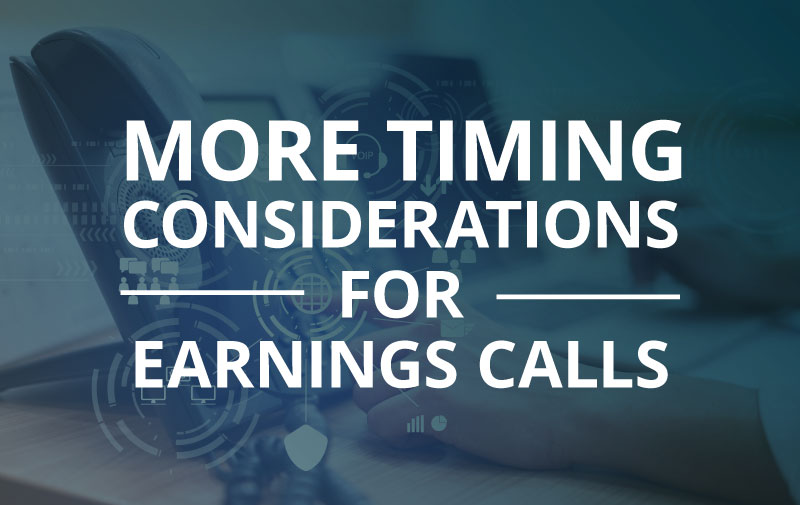In a 2017 blog titled Important Timing Considerations For Earnings Calls, we covered several things to keep in mind when scheduling quarterly earnings calls. In this blog we will review the quarterly reporting requirements and expand and look at a couple more considerations.
An earnings call refers to the time when publicly-traded companies host a conference call to review their financial results of a prespecified, 90-day period. For every earnings call, companies must submit a report to the SEC for review; there are two versions of this report – a 10Q and a 10K. Both types of report summarize the company’s financial performance and disclose certain information to stakeholders and shareholders. 10Qs are filed in conjunction with the results of the first three quarters of a calendar/fiscal year, while 10ks are only filed in the final quarter of the year and include data from the entire twelve months of a company’s calendar/fiscal year.
While the SEC only requires companies to file 10Qs and 10Ks, nearly every company hosts an earnings call prior to filing these reports. This allows management teams to craft and deliver a personalized message to their shareholders and host a live Q&A session with sell-side analysts.
As you might imagine, these calls are very important for both companies and investors. Since quarterly earnings calls are a valuable tool to get new investors to purchase stock and shareholders to hold or increase their position in the stock, everything must be perfect. With a long list of materials to prepare for the call, the date and time of the call can often be overlooked.
Every company has a maximum of 45 days to file a 10Q after the first three quarters and 60 to 90 days to file a 10K after the year-end. Finding the perfect day and time for an earnings call isn’t as much of an issue for larger companies because they have a faster audit process which allows them to schedule their earnings call during a much quieter part of the earnings season. On the other hand, mid to micro-cap companies take longer to complete the audit process and prepare their 10Qs/10Ks and, therefore, have fewer options for scheduling their earnings calls. This results in a competition for the mindshare of Wall Street and the investor community.
For companies trying to expand their reach on earnings calls, there are two very important things to keep in mind: the timing of competitors’ earnings calls and the amount of covering sell-side analysts who will join the call and ask questions.
Timing of Competitors’ Earnings Calls
This first point is important for every company but can have a much bigger impact on smaller public companies. Because investors have limited capacity, especially during earnings season, small companies should avoid making potential investors decide which earnings call they will tune in to.
Although the reasoning behind this strategy is obvious, it can be difficult to execute because most companies set internal dates for their earnings calls at the beginning of each year but do not make the exact dates/time public until an advisory press release is published, roughly two weeks before the call. That said, companies typically follow a pattern and report on the same day of the week for every earnings call. Given that one of the main goals of an earnings call is to maximize exposure to the investment community, finding these trends is definitely worth the time.
To discover such trends, look for the “past events” or the “events and presentations” section on a company’s Investor Relations web page, or look at transcripts of past earnings calls.
Capacity of Sell-side Analysts
In addition to looking at the timing of your competitor’s earnings calls, it can also be beneficial to check on times that work for the covering sell-side analysts.
First, sell-side analysts will likely ask the management team to clarify something that might not have been as clear as intended, or they may even ask the management team to go into greater detail on an important development or aspect of the company. The answers to these questions can save investors valuable time when doing their research after the call.
Second, sell-side analysts that cover your stock want to show their support of the company when they can, so touching base with them regarding their schedule during earnings season is a great way to maintain or strengthen your relationship. It can also help shorten the turnaround time of their research reports that are published after the earnings call.
Conclusion
The earnings season can be a hectic time for all parties involved, but carefully considering aspects that seem small can make all the work and time spent leading up to the main even that much more worthwhile. We closely track the timing of earnings calls each quarter, so contact us for help in optimizing the timing of your quarterly calls.
Hunter Cabi, Analyst


Leave a Reply